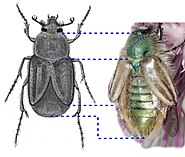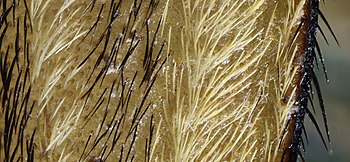Eulasia pareyssei
| Eulasia pareyssei | ||||||||||
|---|---|---|---|---|---|---|---|---|---|---|

Eulasia pareyssei presenting herself |
||||||||||
| Systematics | ||||||||||
|
||||||||||
| Scientific name | ||||||||||
| Eulasia pareyssei | ||||||||||
| ( Brullé , 1832) |
Eulasia pareyssei is a beetle from the family of glaphyridae that to the superfamily of Scarab Beetle-like part. The genus Eulasia is represented in Europe with eight species in three subgenera. Eulasia pareyssei belongs to the subgenus Vittateulasia and occurs only in Southeastern Europe.
Notes on the name
The beetle was first described by Brullé under the name Amphicoma pareyssei in 1832 . The generic name pareyssei refers to the natural produce dealer Ludwig Parreyssi in Vienna. Independently of this, the beetle was also described by Germar in 1834 under the name Amphicoma Laserri . The species name Lasserrei (pronounced Lassēri) should be spelled correctly , because the beetle is from Geneva Cl. Dedicated to Lassere. Later, Germar's description is also cited in the spelling lasserrei and the beetle is mainly called lasserrei . Germar gives a detailed description in Latin and adds a drawing (in Fig. 2 left). Today Eulasia laserri and Eulasia lasserrei are synonymous with Eulasia pareyssei .
The genus Eulasia was Truqui of the genus 1848 Amphicoma separated by Amphicoma only in the strict sense of Latreille , not in the wider sense of Schoenherr defined. Truqui did not mention the meaning of the word Eulasia. However, it is easily made from old gr. λάσιος, lasios for "hairy, shaggy" with the reinforcing prefix ευ- eu- as an indication of the particularly thick hair. The former generic name Amphicoma (old Greek αμφί amphi "around ..." and κόμη kome "hair, mane") alludes to the thick hair. In English, the beetles with the common name are also called bumble bee scarab beetles (bumblebee scarab beetle).
The name of the subgenus Vitateulasia is explained by the fact that the type of the subgenus is the Eulasia vittata described by Fabricius as Melolontha vittata ( Latin banded Melolontha) .
Characteristics of the beetle
The beetle is long and shaggy with hair. There is one special feature to note with regard to the size information. When the wing covers are closed, they cover about four fifths of the abdomen. The body then measures thirteen to fifteen millimeters (Fig. 4). However, when the insect presents itself (taxo picture), it spreads its wings, flattening the abdomen and thus increasing its surface and length considerably. The abdomen becomes up to 40% longer (length comparison Fig. 3).
The head and pronotum are shiny metallic green to golden green, rarely blue-green. The elytra are apparently light and dark brown striped lengthways. The upper side of the abdomen, which becomes visible when the wings are folded away, as well as the underside of the body are gold to gold-green.
The green head (Fig. 2) has long hairs from white to gray-yellow, in the area of the eyes the hair is black. The ten-segment antennae have a large basal segment. Like the following spherical limb, this is dense and long with black hair. The last three antennae segments form a rounded, button-like club. The antennae are black, the club brightened brownish-red. The clypeus above the upper lip is roughly rectangular, rising steeply in front and on the sides and slightly concave in front. In the female it is darkened in front. It is set off from the forehead by a clear seam. At the base it is set out to accommodate the sensor deflection. The upper jaw is not visible from above. The outer edge of the mandibles is rounded, the tip bidentate.
The head, pronotum and the green tag are dense and rather roughly dotted. In the pronotum, the points often touch. The puncture does not extend over the entire pronotum, however, near the base there are also very shiny, unpunctured areas. Fig. 1 shows a section of the pronotum located in front of the label; the hair is combed to the side for a better view, an unpunctured area can be clearly seen as a darker area.
The pronotum is wider than it is long, the front and back corners are rounded. The pronotum is shiny and not shagreened. The base is bordered (in Fig. 1 the border is redrawn in the upper right area of the picture).
The elytra are more dispersed and finer than the head and neck. Together they are slightly wider than the pronotum. They gap at the back and are individually bluntly pointed at the end. They are relatively short and leave the end of the abdomen uncovered.
The elytra are uniformly yellow-brown in color and bordered with black, but they appear striped due to the different colored hairs (Fig. 5). The hair is partly dark brown, partly beige and much shorter than the shaggy body hair. The beige hair forms three longitudinal stripes. The inner one runs along the wing cover seam, the outer one along the outer edge of the wing cover, the third between these two. Between the three beige stripes, almost black hair forms two dark brown vertical stripes. The edge of the elytra is bristly ciliate. The bristles protrude from the side to the back at an angle. The bristled area extends to the majority of the outer edge, the wing cover end and the rear part of the inner edge of the wing covers.
The sides of the abdomen are very densely haired with whitish hairs, towards the end of the body the hairs become yellowish (Fig. 4). The spiracles lie open in the uppermost, laterally located part of the sternites, not in the membrane above.
The tarsi of the legs are all five-limbed. The claws of the claw pair are the same size and without any special features. The front legs are designed as grave legs with three teeth on the outer edge. The tarsi of the foreleg are swiveled in behind the movable mandrel on the inside on the tip of the foreleg. They are slim, the first four limbs longer than they are wide. In the male there is a row of short thick bristles on the inside of the front tarsi that form a comb (Fig. 6) and which are absent in the female. The middle and hind tarsi are fine and densely hairy.
biology
The genus Eulasia together with the genus Pygopleurus represent the most important pollinators of the Poppy Guild, namely of plants with red, odorless, cup- to bowl-shaped flowers with a dark center. Investigations of the visual pigment of Eulasia pareyssei lead to the conclusion that the sensitivity to red colors is relatively high. The beetle can also be found on violet flowers and probably most frequently on yellow flowers.
The animals do not appear until mid-May and often remain until mid-June, but then disappear within a few days. They spend the night and the cool morning hours rigid in flowers and fly around like bees in the warm hours of the day.
distribution
The species occurs in Albania , Macedonia , Bulgaria , Greece , the North Aegean Islands and the European part of Turkey .
Web links
Individual evidence
- ↑ a b c Systematics and distribution of the species Eulasia pareyssei in Fauna Europaea, accessed on January 18, 2017
- ^ A b M. Brullé: Expédition scientifique de Morée , Tome 3, Zoologie, 2nd Section, Paris 1832, p. 183 in the Google book search
- ↑ a b c Sigmund Schenkling: Explanation of the scientific beetle names (species)
- ↑ a b c Germar : Fauna Insectorum Europae , Halle 1824, Fasciculus XVII, tab. (Fig.) 4 not paginated, enter in the search field: Amphicoma Laserri in the Google book search
- ^ A b c d Jaques Baraud: “Contribution à la connaissance du genre Eulasia Truqui…” in Revue Suisse de Zoologie , Volume 97, Issue 1, pp. 107-138 Geneva, March 1990 Species description p. 134 as Eulasia pareyssei
- ↑ a b c Eugenio Truqui: Amphicoma et Eulasia in Studi entomologici , Turin 1848, species description p. 25 as Eulasia lasserrei
- ↑ Camille Jacquelin Du Val: Genera des coléoptères d'Europe comprenant leur classification en familles… , 3rd volume, Paris 1859–1862, explanation of the generic name Amphicoma in the Google book search
- ↑ coleo-net
- ↑ Le Compte de Castelnau: Histoire naturelle des Insectes - Coléoptères , 2nd volume, Paris 1840, p. 153 as Amphicoma pereyssei
- ^ Hermann Burmeister: Handbuch der Entomologie , 4th volume, Berlin 1844, page 23 as Amphicoma Lasserrei in the Google book search
- ↑ Nicole Sommer: When beetles see red Diploma thesis (2010), University of Vienna, Faculty of Life Sciences Abstract






